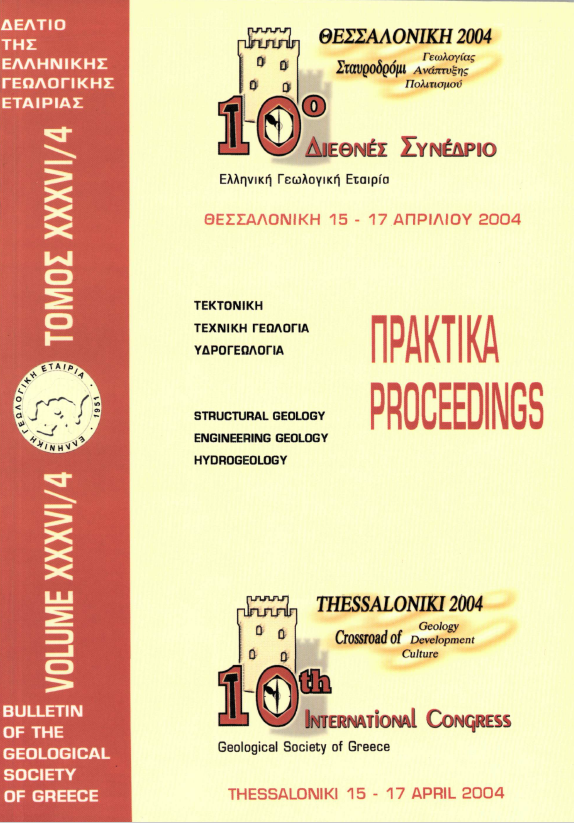THE LANDSLIDE IN THE AREA AGIA-ANNA OF THE SOUTHERN PART OF EUBOEA
Abstract
On 20th February of 2003, an extensive landslide took place at the southern margins of the Agia-Anna village, in the northern Euboea. It caused a lot of material damages (buildings, cemetery and provincial road) and agony in the people of the village, as well as a lot of problems to their properties. In this paper it is described the phenomenon, the form of the landslide and the reasons which caused it, and the mechanism of the breaking and movement are also dilated. The main and secondary breakings of the earth, are extended in an area of 85-90 acres. Their direction is about N-S and the movements are generally directed to the eastern with a resultant ASA. The breakings depth must be not more than 3-4 meters. Most of them are of the order of 0,50-1,5 m and they are not continuous but interrupted. The breakings are usually in a straight line and are arrangement in steps like gravity faults. The length of a continuous breaking is between of 1 to 30 m. In the area where the breakings are noticed, the morphological dip of the soil, before the landslide had been happened, was of the order of 13 to 14%. The drainage basin in the same area is not big enough to concentrate substantial amount of water. Therefore, additional factors, must have also influenced it. It is estimated that these factors are: a. The imperfect drainage of the rain waters and soil saturation through the fissures, because of small landslides and creeps. b. It is possible that small faults (small metaneogenic gravity faults) with parallel direction to the slope, to have acted as sliding surface. The small faults (gravity faults of some cm) are not visible in the argillo-marlaceous material, but it is rumoured to be, comparatively with the obvious tectonic character of the area. c. The mineral constituents of the argillo-marlaceous neogenic sediments, especially the montmorillonite, chlorite, illite, kaolinite and swelling chlorite, as well as their mechanical features, have contributed substantially to the development of landslide. d. The possibility that the neogenic formations are supplied sideways with water, by the adjoining and underlying carbonate rocks, it is also examined.
Article Details
- How to Cite
-
Αντωνίου M., Γαλανοπούλου S., Λυκούδη E., & Φυτρολάκης N. (2004). THE LANDSLIDE IN THE AREA AGIA-ANNA OF THE SOUTHERN PART OF EUBOEA. Bulletin of the Geological Society of Greece, 36(4), 1728–1734. https://doi.org/10.12681/bgsg.16582
- Section
- Engineering Geology, Hydrogeology, Urban Geology

This work is licensed under a Creative Commons Attribution-NonCommercial 4.0 International License.
Authors who publish with this journal agree to the following terms:
Authors retain copyright and grant the journal right of first publication with the work simultaneously licensed under a Creative Commons Attribution Non-Commercial License that allows others to share the work with an acknowledgement of the work's authorship and initial publication in this journal.
Authors are able to enter into separate, additional contractual arrangements for the non-exclusive distribution of the journal's published version of the work (e.g. post it to an institutional repository or publish it in a book), with an acknowledgement of its initial publication in this journal. Authors are permitted and encouraged to post their work online (preferably in institutional repositories or on their website) prior to and during the submission process, as it can lead to productive exchanges, as well as earlier and greater citation of published work.



